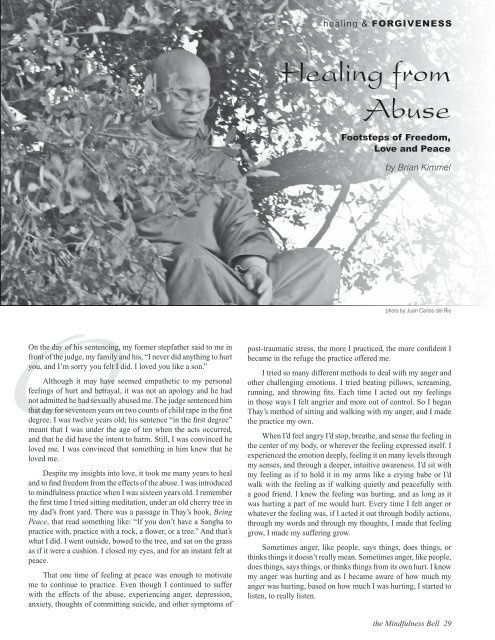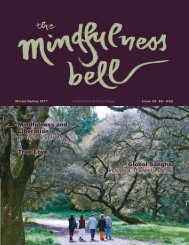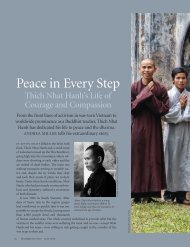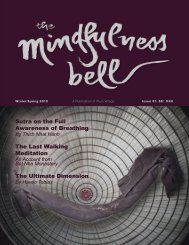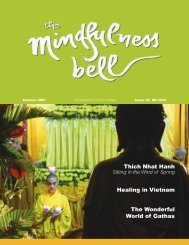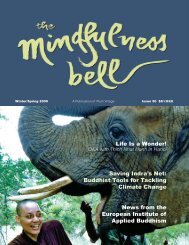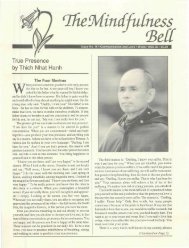View full issue in PDF - The Mindfulness Bell
View full issue in PDF - The Mindfulness Bell
View full issue in PDF - The Mindfulness Bell
- No tags were found...
Create successful ePaper yourself
Turn your PDF publications into a flip-book with our unique Google optimized e-Paper software.
heal<strong>in</strong>g & FORGIVENESSHeal<strong>in</strong>g fromAbuseFootsteps of Freedom,Love and Peaceby Brian Kimmelphoto by Juan Carlos del RioOOn the day of his sentenc<strong>in</strong>g, my former stepfather said to me <strong>in</strong>front of the judge, my family and his, “I never did anyth<strong>in</strong>g to hurtyou, and I’m sorry you felt I did. I loved you like a son.”Although it may have seemed empathetic to my personalfeel<strong>in</strong>gs of hurt and betrayal, it was not an apology and he hadnot admitted he had sexually abused me. <strong>The</strong> judge sentenced himthat day for seventeen years on two counts of child rape <strong>in</strong> the firstdegree. I was twelve years old; his sentence “<strong>in</strong> the first degree”meant that I was under the age of ten when the acts occurred,and that he did have the <strong>in</strong>tent to harm. Still, I was conv<strong>in</strong>ced heloved me. I was conv<strong>in</strong>ced that someth<strong>in</strong>g <strong>in</strong> him knew that heloved me.Despite my <strong>in</strong>sights <strong>in</strong>to love, it took me many years to healand to f<strong>in</strong>d freedom from the effects of the abuse. I was <strong>in</strong>troducedto m<strong>in</strong>dfulness practice when I was sixteen years old. I rememberthe first time I tried sitt<strong>in</strong>g meditation, under an old cherry tree <strong>in</strong>my dad’s front yard. <strong>The</strong>re was a passage <strong>in</strong> Thay’s book, Be<strong>in</strong>gPeace, that read someth<strong>in</strong>g like: “If you don’t have a Sangha topractice with, practice with a rock, a flower, or a tree.” And that’swhat I did. I went outside, bowed to the tree, and sat on the grassas if it were a cushion. I closed my eyes, and for an <strong>in</strong>stant felt atpeace.That one time of feel<strong>in</strong>g at peace was enough to motivateme to cont<strong>in</strong>ue to practice. Even though I cont<strong>in</strong>ued to sufferwith the effects of the abuse, experienc<strong>in</strong>g anger, depression,anxiety, thoughts of committ<strong>in</strong>g suicide, and other symptoms ofpost-traumatic stress, the more I practiced, the more confident Ibecame <strong>in</strong> the refuge the practice offered me.I tried so many different methods to deal with my anger andother challeng<strong>in</strong>g emotions. I tried beat<strong>in</strong>g pillows, scream<strong>in</strong>g,runn<strong>in</strong>g, and throw<strong>in</strong>g fits. Each time I acted out my feel<strong>in</strong>gs<strong>in</strong> those ways I felt angrier and more out of control. So I beganThay’s method of sitt<strong>in</strong>g and walk<strong>in</strong>g with my anger, and I madethe practice my own.When I’d feel angry I’d stop, breathe, and sense the feel<strong>in</strong>g <strong>in</strong>the center of my body, or wherever the feel<strong>in</strong>g expressed itself. Iexperienced the emotion deeply, feel<strong>in</strong>g it on many levels throughmy senses, and through a deeper, <strong>in</strong>tuitive awareness. I’d sit withmy feel<strong>in</strong>g as if to hold it <strong>in</strong> my arms like a cry<strong>in</strong>g babe or I’dwalk with the feel<strong>in</strong>g as if walk<strong>in</strong>g quietly and peace<strong>full</strong>y witha good friend. I knew the feel<strong>in</strong>g was hurt<strong>in</strong>g, and as long as itwas hurt<strong>in</strong>g a part of me would hurt. Every time I felt anger orwhatever the feel<strong>in</strong>g was, if I acted it out through bodily actions,through my words and through my thoughts, I made that feel<strong>in</strong>ggrow, I made my suffer<strong>in</strong>g grow.Sometimes anger, like people, says th<strong>in</strong>gs, does th<strong>in</strong>gs, orth<strong>in</strong>ks th<strong>in</strong>gs it doesn’t really mean. Sometimes anger, like people,does th<strong>in</strong>gs, says th<strong>in</strong>gs, or th<strong>in</strong>ks th<strong>in</strong>gs from its own hurt. I knowmy anger was hurt<strong>in</strong>g and as I became aware of how much myanger was hurt<strong>in</strong>g, based on how much I was hurt<strong>in</strong>g, I started tolisten, to really listen.the M<strong>in</strong>dfulness <strong>Bell</strong> 29


